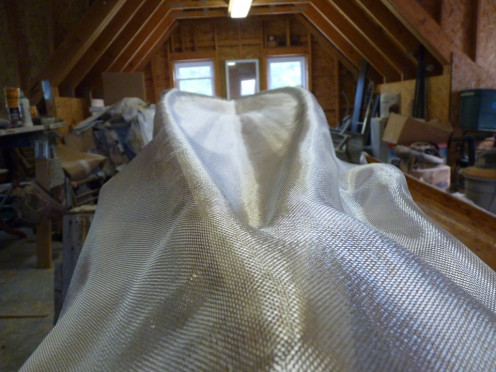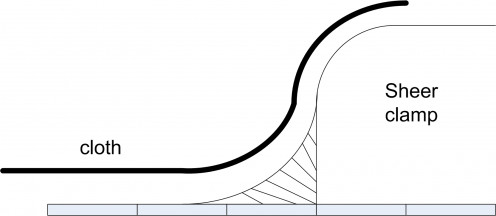Building a Cedar Strip Kayak: The Details: Interior Fiberglass




After a thorough round of planning, sanding, patching and more sanding on both the lower half and deck interior sides I was ready to apply the fiberglass. I did not do finish sanding, I only used 60 and 80 grit. I have to say that after building 4 cedar strip boats I am less picky about the smoothness of surface. I still try to eliminate sharp edges but I tolerate some lumpiness. The exterior surfaces get most of my attention when it comes to sanding.



I used the same method as discussed in my other hubs to apply the fiberglass, that is apply with a brush and then squeegee once the epoxy has had time to soak in. I only used two coats of resin/hardener on the interior surfaces. For the interior of the lower hull half I used S-glass which according to the distributor is “High performance fiberglass with better strength and stiffness compared to standard e-glass". I ordered 6 yards of 30” wide 4 ounce cloth. For the underside of the deck I used the same 30” wide 4 ounce cloth that was applied to the topside.

The interior presents some challenges when laying the cloth and applying the resin. Once I get the cloth to lie on the interior I clamp the edges to the hull. At the point of the bow and stern I cut the cloth allow the stems to come though, so the cloth lies on either side of the stem. When using the squeegee to pull off the extra resin, you can cause the cloth to lift when rounding the bilge if too much pressure is applied. Eventually you will get a feel for how the cloth and resin blend. I like to fill the area around the stems with thickened epoxy. I think it adds a little strength to that part of the hull. The first coat was allowed to dry until it was lightly tacky then I applied the second coat. I brushed epoxy only up from the center about 2/3 of the way to the top, then pulled the excess with a squeegee to fill the remainder.


For added strength I applied approximately 8 inch wide strips of left over 4 oz. cloth across the bottom of spaced about 4 inches apart but only in the center 2/3 of the hull. Previously I have used one large piece of cloth but I thought the strips would save some weight. I applied these immediately after the second coat of epoxy and wetted them generously with more epoxy. Thee s-glass combined with the added re-enforcement strips resulted in a very stiff hull. This is what I wanted.



A large fillet of thickened epoxy must be applied to the underside of the deck between the edge of the sheer clamp and the strips. This adds strength and allows the cloth to form nicely around the sheer clamp. I applied the thickened epoxy, let it dry then sanded it to make a nice concave surface. It had several small voids so I applied another coat of not quite so thick epoxy/sanding dust mixture, let it dry then sanded again.
Links to my other cedar strip kayak hubs
- Building a Cedar Strip Kayak: The Details: Lofting the Plans
I decided to build another cedar strip kayak. I’ve kind of had an itch to build another boat. I previously built two cedar strip canoes and one cedar strip kayak. I want to take the less expensive route, so I will do some things to cut costs. - Building a Cedar Strip Kayak: The Details: Making and Setting Up the Forms
Making forms that determine the shape of the hull and deck, then setting them up on a build table for construction of a Cedar Strip Kayak. - Building a Cedar Strip Kayak: The Details: Stems and Sheer Clamp
The stems on a wood strip kayak are ¼ strips of wood which are steamed, shaped and glued together with thickened epoxy. The sheer clamp is what is used to attach the deck to the bottom of the hull. - Building a Cedar Strip Kayak: The Details: Stripping the Hull
This is the step in the build process where your kayak actually starts to look like something. This can be a source of motivation. - Building a Cedar Strip Kayak: The Details: Exterior Fiberglass and Planking the Deck
Once you have completed all of the sanding and caressing of wood in the lower part of the hull it is time to apply the fiberglass and epoxy







